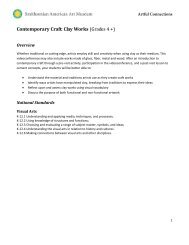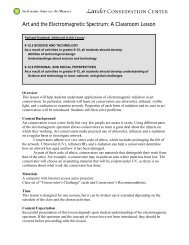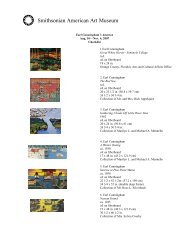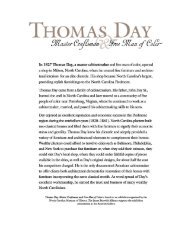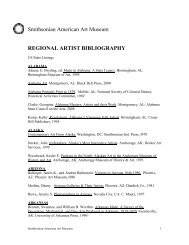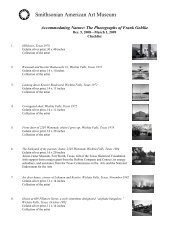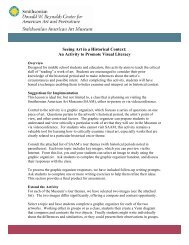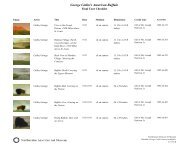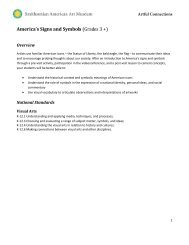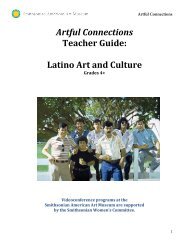Smithsonian American Art Museum Wall Text & Extended Labels
Smithsonian American Art Museum Wall Text & Extended Labels
Smithsonian American Art Museum Wall Text & Extended Labels
Create successful ePaper yourself
Turn your PDF publications into a flip-book with our unique Google optimized e-Paper software.
Aspects of Negro Life<br />
In 1934, Aaron Douglas was commissioned by the Public Works of <strong>Art</strong> Project, the first relief program for artists<br />
sponsored by President Franklin Roosevelt’s New Deal, to create a mural program for the 135th Street branch of<br />
the New York Public Library. The four panels of Aspects of Negro Life chart the progression of African <strong>American</strong>s<br />
from Africa through slavery, Reconstruction, the Northern Migration, and the Great Depression. Using a stylized<br />
vocabulary, Douglas conveyed political and social messages and included allusions to Marxist theory that he and<br />
others in Harlem studied in the mid‐1930s.<br />
Aspects of Negro Life reveals the bold modernist risks Douglas was prepared to take at a time when regionalism<br />
was the norm. The layered, condensed space, geometric forms, and silhouettes draw on African, cubist, and<br />
constructivist motifs in an allegorical representation of issues central to African <strong>American</strong> history and<br />
contemporary life.<br />
Fisk University<br />
In the summer of 1929, Fisk University president Thomas Elsa Jones asked Charles S. Johnson, the editor of<br />
Opportunity magazine and a major figure in the Harlem Renaissance, to suggest an artist to create murals for the<br />
university’s new Cravath Memorial Library. Johnson immediately recommended Douglas, and in the spring of<br />
1930, Douglas began his first major mural commission.<br />
Douglas chose the “panorama of the development of Black people in this hemisphere” as his subject. The series<br />
begins in Africa, the ancestral homeland of black <strong>American</strong>s, and continues with images of captivity, slavery,<br />
emancipation, and modern life. To emphasize the importance of education, Douglas also depicted the liberal<br />
arts—poetry, philosophy, drama, music, and science—hoping the murals would promote black identity and a<br />
sense of dignity among the Fisk students. In 1937, after Johnson was named the first African <strong>American</strong> president<br />
of the university, Douglas returned to establish the art department.<br />
Portraits, Prints, and Scenes of Daily Life<br />
Douglas explored multiple styles throughout his career. The modernist “public” style for which he is best known<br />
features flat, silhouetted figures, a limited color palette, and radiating bands and circles of light. He typically<br />
painted portraits, landscapes, and genre scenes with a looser brush and more naturalistic approach in which<br />
space, volume, and light are realistically rendered.<br />
The Legacy of Aaron Douglas<br />
Aaron Douglas forged a powerful aesthetic that was conceptual yet optical, spiritual yet real, political yet<br />
visual. His vision of life and of the hardships and hopes experienced by African <strong>American</strong>s influenced<br />
generations of artists during his lifetime and later. At Douglas’s memorial service in Nashville in 1979,<br />
Fisk University president Walter J. Leonard praised the artist as “one of the most accomplished of the<br />
interpreters of our institutions and cultural values. He captured the strength and quickness of the young;<br />
he translated the memories of the old; and he projected the determination of the inspired and<br />
courageous.”



